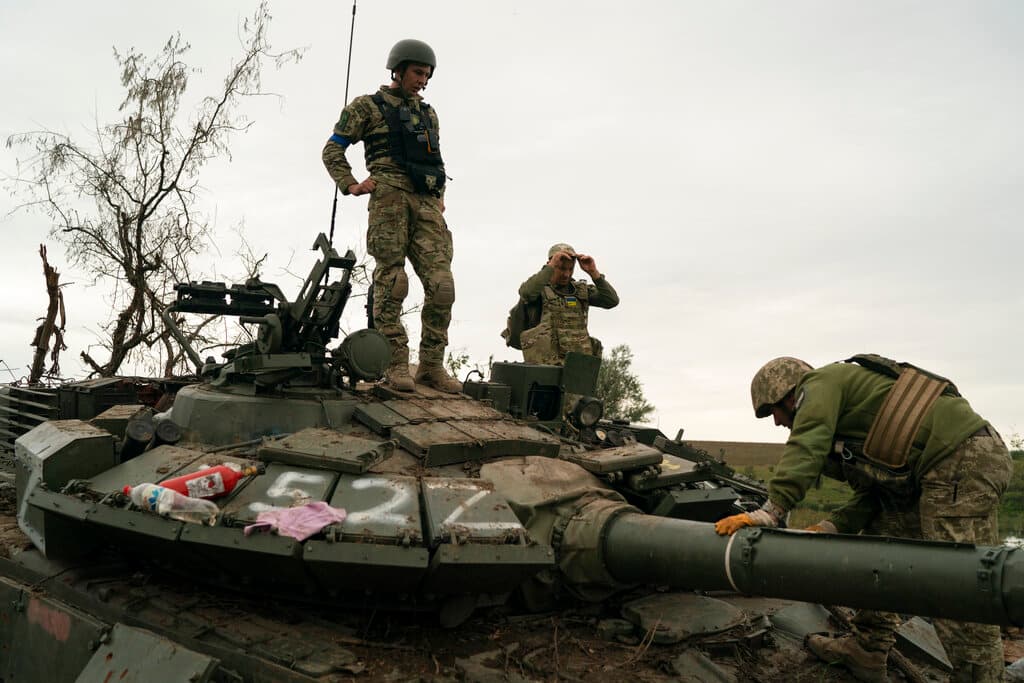Russia’s Army Starts To Crack
Modernizing an old theme of 20th century military history, Ukraine has inaugurated a toll-free surrender line for Russian soldiers and units.

Helped along by Hollywood and the press, many Westerners have come to see the Russian fighting man as a superman. Russia’s historical record, though, is not always so heroic. In World War 1, 3.3 million Czarist Russian soldiers raised their hands and surrendered. In World War II, 5.7 million Red Army soldiers surrendered.
This month, flight and surrender were the hallmarks of Russia’s debacle in northeastern Ukraine. In two weeks, Russia lost 3,500 square miles of occupied land. Thousands of Russian soldiers scampered back across the border.
They left lunches on tables. They stole civilian clothes and cars. At Stanytsia Luhansk, a checkpoint into Russia-controlled Ukraine, a line of cars reportedly stretched for five miles. Hundreds of slower-moving Russian soldiers waved white T-shirts and gave up.
In one week, Oryx, a military analysis website, documented 580 pieces of major Russian equipment — largely tanks and armored personnel carriers — that were abandoned or destroyed in Ukraine’s Kharkiv region.
Since attacking Ukraine on February 24, Russia has lost nearly 6,000 major pieces of military equipment, far more than Ukraine’s losses. Ukrainians call this largesse ‘російський ленд-ліз’ — or Russian Lend Lease, referring to the American aid that saved the Soviet Union in World War II.
A Russian military blogger and former intelligence colonel with half a million followers on Telegram, Igor Girkin, bitterly compared the Kharkiv defeat to the Battle of Mukden in Manchuria. This was Czarist Russia’s turning point in the 1905 Russo-Japanese War. Girkin did not mention that in two weeks, 22,000 Russian soldiers surrendered — compared to 2,000 Japanese.
The difference is between a serf army and a citizen army. Ukrainian soldiers are overwhelmingly volunteers. They are fighting to defend their land, their families, and their properties from a foreign invader. In contrast, Russia increasingly scrapes the bottom of the barrel to fill its ranks.
Russia increasingly relies on recruits from such impoverished peripheral regions as Altai, Buryatia, Dagestan, North Ossetia and Tuva. For contract soldiers, pay can be between three and four times the local average. In Sakhalin, the island in the Russian Far East, the signing bonus is $5,000 — nearly one year’s pay.
The head of a prisoner rights group, Russia Behind Bars, Olga Romanova, says that one close Putin ally, Yevgeny Prigozhin, seeks to recruit up to 50,000 prisoners with the offer of high pay and get-out-of-jail-free cards. Mr. Progozhin warns that deserters will be executed.
Word of high mortality rates in Ukraine — last month, the U.S. government estimated up to 80,000 Russian soldiers have been killed or wounded — filtered into the prisons. Only 5,000 Russian prisoners have signed up.
Desperate to meet quotas, the Army in one city targets alcoholics, Igor Eidman writes. In his hometown of Nizhny Novgorod, recruiting posters for contract soldiers are placed around stores that sell “samogon” — cheap moonshine.
In Russian-occupied Donbas, there are reports of men hiding in apartments for months at a time and of waiters press-ganged straight from restaurants into military service. Last week in Kharkiv, many of these soldiers cut and run. Back in the Luhansk People’s Republic, these draftees complained last week that their Russian officers had abandoned them.
On Russia’s state-controlled TV, commentators say that President Putin faces a choice: a national emergency draft or peace talks with Ukraine.
“It’s impossible to defeat Ukraine using the resources that Russia is now trying to fight with… contract soldiers, mercenaries, and no general mobilization,” a former Russian lawmaker, Boris Nadezhdin, lamented last weekend on Russia’s NTV.
In Ukraine, Russian surrenders and desertions are expected to grow. In Kherson, Russia’s only foothold on the west bank of the Dnipro River, about 25,000 Russian soldiers are trapped in a steadily tightening Ukrainian Army noose.
With their backs to the river and winter coming, Russians fear that Mr. Putin will take a page from Stalin’s strategy to liberate Stalingrad. There, ‘barrier units’ fired on soldiers attempting to flee across the Volga.
On Monday, a Ukraine Armed Forces spokeswoman, Natalia Humeniuk, said Russian units Kherson “are trying to negotiate with the Ukrainians on surrender. The toll-free number is taking calls. Russian-speaking operators are standing by.
Mr. Brooke is a non-resident Russia-Ukraine fellow for the Foundation for Defense of Democracies.

